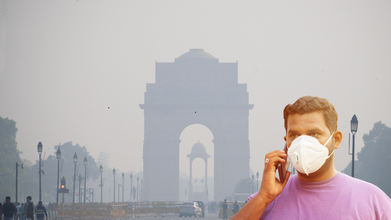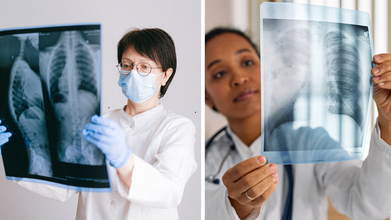- Health Conditions A-Z
- Health & Wellness
- Nutrition
- Fitness
- Health News
- Ayurveda
- Videos
- Medicine A-Z
- Parenting
As The Weather Gets Cold, Your Teeth Might Feel It More Than You Think, Says Doctor

Credits: iStock
The UK recorded its coldest autumn so far when the temperatures fell as low as -12.6C in Scotland. This was the lowest recorded in November from the last 15 years. The mercury also fell to -7.6C in Wales, -6C in Northern Ireland and -6.7C in England. Cold health alters have been issued in England. The UK Health Security Agency (UKHSA) has issued amber cold-health alerts for North West, North East, and Yorkshire and Humber, while other areas are under yellow alerts.
With this new developments, a Yorkshire dentists has pointed out that cold weather could, in fact, impact one's dental health.
Dr Abdul Dalghous, a dentist at Yorkshite Dental Suite said that chilly weather can trigger changes inside your mouth. Even if you have not notices them before, the change in weather and the temperature drop could negatively impact your dental health.
What Does The Doctor Say?
Sensitivity
The doctor says that there could be sudden sensitivity that one can feel when the weather is cold outside. "If you feel a sharp, almost electric twinge in your teeth when you breathe in icy air, it may be a sign that your enamel is under strain," explains the doctor.
Dr Dalghous explains that sudden cold exposure could make teeth contract quickly, irritating the nerves inside the tooth.
Teeth Ache
The cold weather can slightly weaken your immune system, making you more susceptible to illnesses such as colds. The doctor explains, "It’s very common for sinus pressure to feel like a toothache. This is due to your sinuses swelling and pressing on the roots of your upper teeth, often creating a dull, aching sensation. Many people mistake this for dental pain when the real culprit is winter congestion."
Dry Mouth
Another common experience during winters is having a dry mouth. This happens because cold air tends to be less humid and thus breathing it in through your mouth could lead to a drier mouth than usual. "Saliva acts as your mouth's natural defense system, so, when levels drop, your teeth become more vulnerable to sensitivity, plaque build-up and decay," the doctor notes.
Pain While Drinking Cold Beverages Or Eating Cold Food
Winter weather could further amplify the discomfort that is caused by cold food or drinks. "If a sip or bite of a chilled snack causes pain that lingers, it could point to underlying issues such as enamel erosion, cavities or exposed dentine that are becoming more noticeable in colder weather.”
Small Cracks Could Be More Noticeable
Teeth naturally expand and contract when exposed to temperature shifts, and winter tends to make these changes more intense. Over time, this added stress can lead to tiny hairline cracks in the enamel. You may not spot them, but you might feel rough spots, sudden sensitivity in one area, or small chips you never noticed before.
Dr Abdul adds: “To help ease these changes, we recommend breathing through your nose where possible and avoid biting into cold foods. When it comes to your oral hygiene ensure you’re brushing twice a day using toothpaste designed for sensitivity and flossing. Following these will help your teeth during this cold weather!”
Are You Still An Adolescent At 32? Study Says Yes

Credits: iStock
Your adolescence lasts well up to your 30s. A new, "cool" study as Prof Tara Spires Jones, tells BBC, noted that the human brain does not follow a simple, steady path from birth to old age. Instead, it moves through five clear phases, each marked by a shift in how its networks connect and communicate. The study is conducted by the researchers from the University of Cambridge, who analyzed thousands of brain scans to track how neural connections strengthen, weaken, and reorganize over time.
This large study involved nearly 4,000 people between infancy and age 90 and has now mapped these transitions, offering new insights into why periods of life differ so much in terms of learning, behaviors, and vulnerability to mental health conditions.
Their work shows that the brain remains in an adolescent state far longer than earlier believed and reaches a peak of efficiency only in the early thirties. The findings, published in Nature Communications, highlight striking turning points at the ages of nine, 32, 66 and 83.
The Five Phases Of Brain
Childhood: Birth to Age Nine
The study showed that during childhood, the brain grown rapidly, however, it also begins trimming the vast numbers of synapses formed in early life. This is what helps the brain decide which pathways truly matter. However, this period is not very efficient. It resembles a child wandering without a fixed route, exploring freely rather than moving directly from one point to another. The purpose is exploration, not precision.
Adolescence: Age Nine to 32
A dramatic shift begins around age nine. The brain enters a long stretch of heightened efficiency as it reorganizes its neural networks with remarkable speed and intensity.
This is the phase where mental health vulnerabilities often emerge, since the brain is restructuring at an unusually rapid pace.
This part of the study also breaks the conventional idea that associated adolescence typically with the teenage years. Modern neuroscience suggests it extends into the twenties. This study pushes that boundary even further, indicating that the adolescent phase may last all the way to 32.
During this time, the brain reaches its most efficient point, and many cognitive abilities are thought to peak.
Adulthood: Age 32 to 66
After the long adolescent stretch, adulthood brings stability. The study shows that adulthood actually comes from the age 32, again a shift from what conventionally was believed adulthood to be. This is the brain’s most settled era, lasting more than three decades. Change continues, but at a gentler pace and in a more predictable pattern. The efficiency gained earlier begins to level out. Many people recognize this phase as a period when their cognitive strengths, personality and sense of self feel most consistent. The fireworks of earlier development give way to a steady rhythm.
Early Aging: Age 66 to 83
The period after 66 marks the beginning of early ageing. It does not arrive as a sudden decline. Instead, there are subtle shifts in how different parts of the brain coordinate.
Rather than functioning as one unified network, the brain begins to break into clusters of regions that work more closely within their own groups. It is similar to a band whose members start pursuing individual projects while still occasionally performing together.
Although the study focused on healthy brains, this is also the age when conditions linked to ageing, such as high blood pressure and dementia, begin to appear more frequently.
Late Aging: 83 And Beyond
The final phase begins at around 83. Data for this group was more limited, since it is harder to find older adults with no underlying health issues. Even so, the scans show that the patterns seen in early ageing become more pronounced. The brain’s networks continue to drift apart, and communication between regions becomes less synchronized.
The Risk You Didn't Know: Delhi's Toxic Air Can Also Impact Your Blood Health

Credits: iStock
As of 8.30 am, the pollution levels in New Delhi stood at the AQI of 293, according to aqi.in, which is equivalent to smoking 8.9 cigarettes per day, 62.3 cigarettes per week, and around 267 cigarettes per month, based on the average PM2.5 concentration over the last 24 hours.
While GRAP measures have been implemented in Delhi, there are still a section of people who continue to step out for work and other chores. From time and again experts, doctors, and researcher have pointed out the negative health impact the pollution bears on people. It is no longer limited to lungs or respiratory issues, but goes much beyond it. Ambient air pollution is responsible for fertility issues, bone health, and even cognitive risks like dementia, and more.
However, there is another health risk that people did not know can be impacted by pollution. It is your blood health or blood function.
What Is Blood Health?
Blood health refers to blood's ability to perform its vital functions, which includes transporting oxygen, nutrients, fighting infections, and regulating body temperature. Unhealthy blood could lead to disorders like anemia, blood clots, or even blood cancer.
How Does Air Pollution Impact Blood Health?
As per a 2024 study published in the journal BMC Public Health, titled Association of Ambient Air Pollution With Hemoglobin Levels and Anemia In The General Population of Korean Adults noted the detrimental effects of air pollution exposure on hemoglobin concentrations and anemia in specific populations, which included children, pregnant women, and the elderly.
The study noted that the pollutants in the air contributes to disturbances in iron homeostasis, thus the exposure to air pollution leads to cellular iron deficiency through the activation of oxidation production. It also increases secretion of pro-inflammatory mediators. This pro-inflammatory cytokines that are now increased cause a deficiency erythropoietin secretion, resulting in anemia.
In addition, exposure to air pollution increases the secretion of reactive oxygen species, resulting in oxidative stress. In 2008, an experimental study in a murine model reported that oxidative stress was closely related to iron deficiency anemia.
Another advisory from 2024, published in the National Institute of Health's (NIH) official website states that long term exposure to air pollution is linked to blood clots in veins that bring blood to the heart. The study was published by NIH, which included 6,651 US adults who were followed for an average 17 years between 2000 and 2018. Throughout the study, 284 adults developed blood clots in deep veins. Whereas 89% to a more than two-fold increases risk based on long term exposure was also noted for those who lived near polluted areas.
"Exposure to air pollution, which can set the stage for inflammation and contribute to blood clotting, has long been associated with cardiovascular and respiratory diseases. While previous research has also suggested a link to VTE, this is the largest, most comprehensive U.S. study to report that association with three different types of air pollutants," the advisory read.
The pollutants included particulate matter, which are tiny particles equal to or less than 2.5 micrometers, which can be inhaled easily, and can penetrated through every organ, and enter your blood streams.
Furthermore, pollutants like PM2.5 and PM10, benzene, polycyclic aromatic hydrocarbons and heavy metals like arsenic and lead could also be absorbed into the lungs and passed to blood streams. These trigger oxidative stress, DNA damage and inflammatory responses, all of which contribute to abnormal cell growth and mutations in blood cells. A comprehensive review published by the World Health Organization (WHO) suggested that this exposure could also increase the risk of blood cancer by 15 to 40% in people, depending on the exposure of pollution.
How 26,000 Lives Could Be Saved Each Year With Just One Change to Lung Cancer Screening

Credits: Canva
If screening is made available and accessible to those between 40 to 85 years of age, it could detect 94% of lung cancers. Even if 30% of people get screened, it could prevent 26,000 deaths in the US. Despite that, the screening for the deadliest cancer in the US still misses most cases, reveals a JAMA Network study. As per the American Cancer Society, 226,650 new cases of lung and bronchus cancer in 2025, the Centers for Disease Control and Prevention (CDC) notes 18,893 new cases in 2022. As for deaths, the American Cancer Society estimates around 124,730 lung cancer deaths in 2025.
The Washington Post reports that when a 42-year-old mother of three, Jessie Creel first developed a stubborn cough in May last year, she did what most people would do. She went to her doctor, took the prescribed antibiotics and hoped to bounce back quickly. Instead, her cough worsened. She began losing weight, struggled to sleep and even coughed up blood during a camping trip. Nothing about it felt normal anymore.
Six months later, she was diagnosed with Stage 4 lung cancer. Creel ran, swam, avoided alcohol and had never smoked, yet her cancer had spread to her bones, brain and lymph nodes by the time it was detected. Her story is becoming more familiar among cancer specialists, who now say lung cancer is no longer a disease that fits the old stereotype of the heavy smoker. The JAMA Network study is pushing experts to ask whether current lung cancer screening guidelines are excluding thousands of people who might benefit from early detection.
The Current Screening Rules That Limits People From Getting Themselves Screened
Right now, lung cancer screening in the United States is recommended only for people between 50 and 80 who have a heavy smoking history and who either still smoke or quit within the last 15 years. However, the researchers of the new study examined around 1000 lung cancer patients treated at Northwestern Medicine. Only one third would have qualified for screening under today’s guidelines. Women, people of color and those who had never smoked made up a large portion of the patients who fell outside the criteria.
According to the study’s authors, this means most lung cancer cases in the country are detected only after symptoms appear, which often happens when the cancer has already advanced.
Experts suggest a broader, age based approach similar to breast or colon cancer screening. If everyone between 40 and 85 could get screened, researchers estimate that nearly 94 percent of lung cancer cases could be identified, potentially preventing more than 26,000 deaths each year even if only a fraction of eligible people participated.
How Is Lung Cancer Detected?
For those who qualify, lung cancer screening is done using a low dose CT scan once a year. These scans use far less radiation than a regular CT and have been shown to catch cancers early.
The U.S. Preventive Services Task Force guidelines decide who gets insurance covered screening. The American Cancer Society has its own recommendation, which is slightly more flexible but does not guarantee full coverage.
Doctors say that when lung cancer is caught early through screening, cure rates can exceed 90 percent. But many people who do not meet today’s criteria never get that chance and are often diagnosed only once symptoms set in. By that stage, treatment is more complex and outcomes are less optimistic.
Why Are Experts Asking For A Change In System?
Lung cancer remains the leading cause of cancer related deaths. It kills more people than breast, colon and prostate cancers combined. Yet smoking rates have dropped significantly over the years, which means screening based on smoking history alone no longer reflects who is actually getting sick.
The new study suggests that continuing with the current guidelines would mean detecting only one third of new cases. Experts call the findings alarming and believe shifting to an age based model could save more lives than the number of people who die each year from brain cancer.
Broader screening may also reduce long term healthcare costs. Detecting cancer at Stage 1 rather than Stage 4 could save nearly 25 billion dollars annually in treatment expenses, far outweighing the cost of offering more people access to scans.
© 2024 Bennett, Coleman & Company Limited

